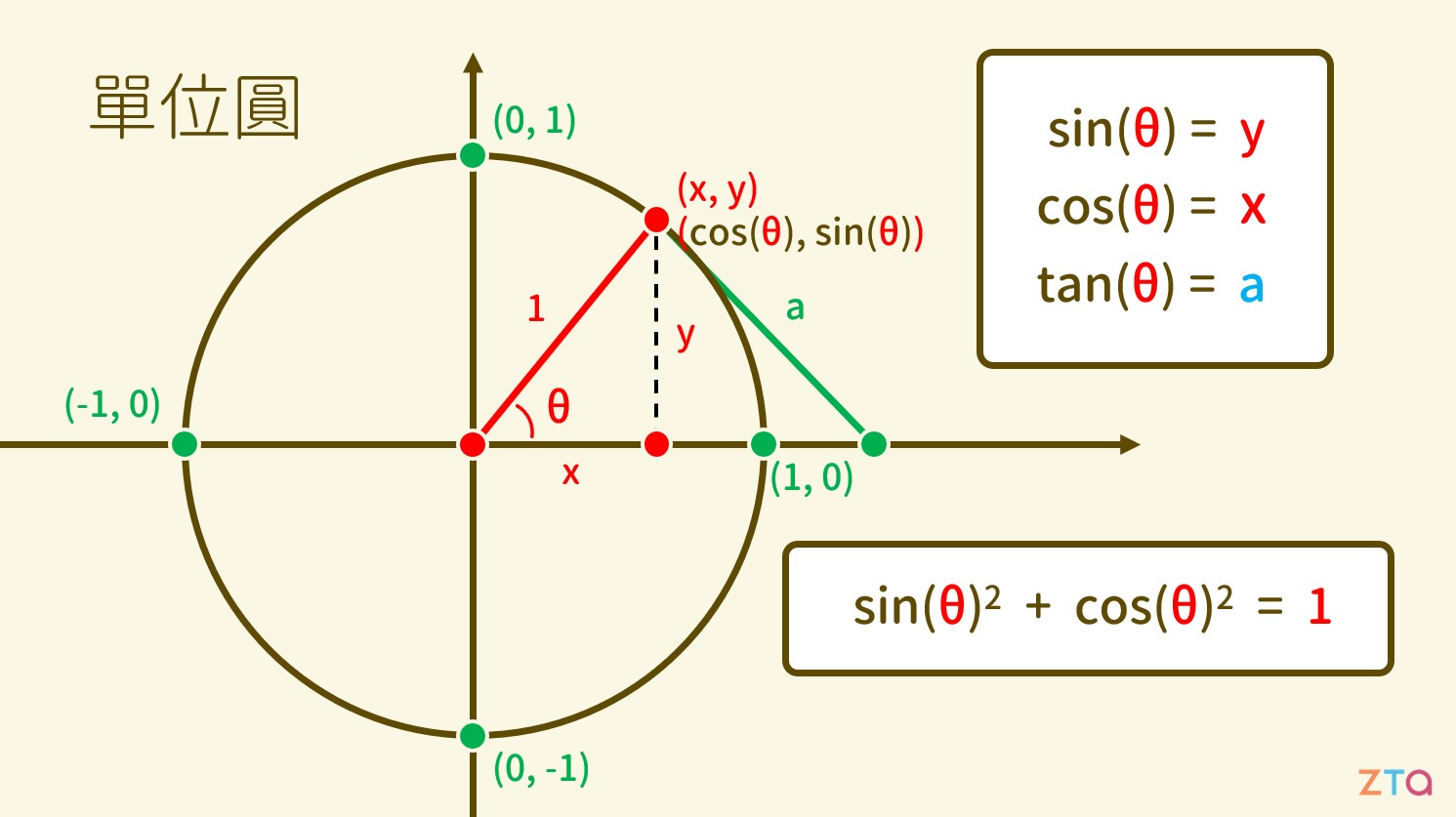尚未建立名稱
能量:0
我的帳號中心
問 學Bot 任何問題!
首頁&搜尋
最愛&收藏
所有課程
分享資源
帳號設定
關於學呀
線上募款
章節設定
章節名稱
章節類別
章節標籤
cos
sin
tan
幾何運算
或者建立新標籤
章節內容
全螢幕編輯與預覽
# 三角函數的定義 三角函數,是人們用來表示三角形上邊長與邊長之間關係的函數。當我們觀察一個直角三角形時,我們可以將各個函數定義作如下($adj$為鄰邊;$opp$為對邊;$hyp$為斜邊): $$ \sin(\theta) = \frac{opp}{hyp} \text{ , } \cos(\theta) = \frac{adj}{hyp} $$ $$ \csc(\theta) = \frac{hyp}{opp} \text{ , } \sec(\theta) = \frac{hyp}{adj} $$ $$ \tan(\theta) = \frac{opp}{adj} \text{ , } \cot(\theta) = \frac{adj}{opp} $$ 利用這些定義,我們可以衍伸出一些式子,表達不同三角函數間的關係: $$ \tan(\theta) = \frac{\sin(\theta)}{\cos(\theta)} \text{ , } \cot(\theta) = \frac{\cos(\theta)}{\sin(\theta)} $$ $$ \sec(\theta) = \frac{1}{\cos(\theta)} \text{ , } \csc(\theta) = \frac{1}{\sin(\theta)} $$  在單位圓中,我們可以將這些函數所對應的值在圖形上表示出來,也就是: $$ \sin(\theta) = y \text{ , } \cos(\theta) = x $$ 而 $\tan(\theta)$ 即為半徑 $r$ 的斜率。 # 衍伸的公式 將 $\cos$ 與 $\sin$ 的定義進行整理,我們可以得到: $$ \sin^2 \theta + \cos^2\theta = 1 $$ $$ \Rightarrow \sin^2\theta = (1+\cos\theta)(1-\cos\theta) $$ $$ \Rightarrow \cos^2\theta = (1+\sin\theta)(1-\sin\theta) $$ 接著一樣很重要的是角度加減的公式: $$ \sin(\alpha+\beta) = \sin\alpha \cdot \cos\beta +\cos\alpha \cdot \sin\beta $$ $$ \sin(\alpha-\beta) = \sin\alpha \cdot \cos\beta -\cos\alpha \cdot \sin\beta $$ $$ \cos(\alpha+\beta) = \cos\alpha \cdot \cos\beta -\sin\alpha \cdot \sin\beta $$ $$ \cos(\alpha-\beta) = \cos\alpha \cdot \cos\beta +\sin\alpha \cdot \sin\beta $$ 藉由 $\sin$ 與 $\cos$ 的加減公式,我們可以得到: $$ \tan(\alpha+\beta) = \frac{\tan\alpha+\tan\beta}{1-\tan\alpha \cdot \tan\beta} $$ $$ \tan(\alpha-\beta) = \frac{\tan\alpha-\tan\beta}{1+\tan\alpha \cdot \tan\beta} $$ 若將 $\alpha$ 和 $\beta$ 代入相同的值,我們便能得到兩倍角公式: $$ \sin(2\theta) = 2\cdot \sin\theta \cdot \cos\theta $$ $$ \cos(2\theta) = \cos^2\theta - \sin^2\theta $$ $$ \tan(2\theta) = \frac{2 \cdot \tan\theta}{1-\tan^2\theta} $$ 將上述公式代入不同符號並整理,可得半角公式: $$ \sin(\frac{\theta}{2}) = \pm \sqrt{\frac{1-\cos\theta}{2}} $$ $$ \cos(\frac{\theta}{2}) = \pm \sqrt{\frac{1+\cos\theta}{2}} $$ $$ \tan(\frac{\theta}{2}) = \pm\frac{\sin\theta}{1+\cos\theta} $$ 最後是 $\sin$ 與 $\cos$ 的加減公式: $$ \sin\alpha + \sin\beta = 2\cdot \sin(\frac{\alpha+\beta}{2})\cdot \cos(\frac{\alpha-\beta}{2}) $$ $$ \sin\alpha - \sin\beta = 2\cdot \sin(\frac{\alpha-\beta}{2})\cdot \cos(\frac{\alpha+\beta}{2}) $$ $$ \cos\alpha + \cos\beta = 2\cdot \cos(\frac{\alpha-\beta}{2})\cdot \cos(\frac{\alpha+\beta}{2}) $$ $$ \cos\alpha - \cos\beta = 2\cdot \sin(\frac{\alpha-\beta}{2})\cdot \sin(\frac{\alpha+\beta}{2}) $$ # 幾何上的運用  當我們有一個三角形,邊長與角度如上圖所示時,則面積會等於一半的兩邊乘上夾角的 $\sin$ 值: $$ \text{Area} =\frac{1}{2}\cdot a\cdot b\cdot \sin(\angle C) $$ 三邊長與對角的關係呈: $$ \frac{a}{\sin\angle A} = \frac{b}{\sin\angle B} = \frac{c}{\sin\angle C} $$ 任意一邊長與另外兩邊的關係為: $$ c^2 = a^2 + b^2 - 2\cdot a\cdot b\cdot \cos\angle C $$ 若我們將 $\angle C$ 以 90度 帶入,則: $$ let \angle C = 90^{\circ} $$ $$ \Rightarrow \cos\angle C = 0 $$ $$ \Rightarrow c^2 = a^2 + b^2 $$ 即得畢氏定理。
儲存章節
前往實際頁面